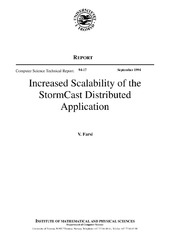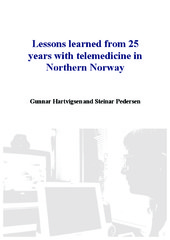Blar i tittel Artikler, rapporter og annet (informatikk)
Viser treff 158-177 av 389
-
Increased scalability of the StormCast distributed application
(Research report; Forskningsrapport, 1994-09)Scaling is recognized as a primary concern in developing distributed applications. Scaling problems occur when an application reach its upper boundary in some way or another. This paper describes the considerations made in the redesign of the StormCast distributed application to achieve more scalability. Naturally, there can be many factors that restrict a system's scalability. The challenge meeting ... -
Influence of Biosynthesized Nanoparticles Addition and Fibre Content on the Mechanical and Moisture Absorption Behaviour of Natural Fibre Composite
(Journal article; Tidsskriftartikkel; Peer reviewed, 2022-12-19)This study looks at how incorporating nanofiller into sisal/flax-fibre-reinforced epoxy-based hybrid composites affects their mechanical and water absorption properties. The green Al2O3 NPs are generated from neem leaves in a proportion of leaf extract to an acceptable aluminium nitrate combination. Both natural fibres were treated with different proportions of NaOH to eliminate moisture absorption. ... -
Information and communication technology-based interventions for chronic diseases consultation: Scoping review
(Journal article; Tidsskriftartikkel; Peer reviewed, 2022-04-29)Background: Medical consultations are often critical meetings between patients and health personnel to provide treatment, health-management advice, and exchange of information, especially for people living with chronic diseases. The adoption of patient-operated Information and Communication Technologies (ICTs) allows the patients to actively participate in their consultation and treatment. The ... -
Integration of solar latent heat storage towards optimal small-scale combined heat and power generation by Organic Rankine Cycle
(Journal article; Tidsskriftartikkel; Peer reviewed, 2020-03-16)Thermal energy and distributed electricity demand are continuously increased in areas poorly served by a centralized power grid. In many cases, the deployment of the electricity grid is not economically feasible. Small-scale Organic Rankine Cycle (ORC) appears as a promising technology that can be operated by solar energy, providing combined heat and power (CHP) generation. Additionally, thermal ... -
Intelligent Offloading Distribution of High Definition Street Maps for Highly Automated Vehicles
(Journal article; Tidsskriftartikkel; Peer reviewed, 2018-11-24)Highly automated vehicles will change our personal mobility in the future. To ensure the safety and the comfort of their passengers, the cars have to rely on as many information regarding their current surrounding traffic situation, as they can obtain. In addition to classical sensors like cameras or radar sensors, automated vehicles use data from a so called High Definition Street Map. Through such ... -
Interdisciplinary optimism? Sentiment analysis of Twitter data
(Journal article; Tidsskriftartikkel; Peer reviewed, 2019-07-31)Interdisciplinary research has faced many challenges, including institutional, cultural and practical ones, while it has also been reported as a ‘career risk’ and even ‘career suicide’ for researchers pursuing such an education and approach. Yet, the propagation of challenges and risks can easily lead to a feeling of anxiety and disempowerment in researchers, which we think is counterproductive to ... -
Intersecting near-optimal spaces: European power systems with more resilience to weather variability
(Journal article; Tidsskriftartikkel; Peer reviewed, 2023-01-03)We suggest a new methodology for designing robust energy systems. For this, we investigate so-called near-optimal solutions to energy system optimisation models; solutions whose objective values deviate only marginally from the optimum. Using a refined method for obtaining explicit geometric descriptions of these near-optimal feasible spaces, we find designs that are as robust as possible to ... -
An introduction to the TACOMA distributed system. Version 1.0
(Research report; Forskningsrapport, 1995-06)This report briefly introduces TACOMA Version 1.0. This distributed system supports agents, computations that can roam the internet. The report presents the TACOMA project, the computational model, how to get started, and the basic TACOMA abstractions. -
Inverse and efficiency of heat transfer convex fin with multiple nonlinearities
(Journal article; Tidsskriftartikkel; Peer reviewed, 2021-07-22)In this article, we first propose the novel semi-analytical technique—modified Adomian decomposition method (MADM)—for a closed-form solution of the nonlinear heat transfer equation of convex profile with singularity where all thermal parameters are functions of temperature. The longitudinal convex fin is subjected to different boiling regimes, which are defined by particular values of n (power ... -
An investigation of combined effect of infill pattern, density, and layer thickness on mechanical properties of 3D printed ABS by fused filament fabrication
(Journal article; Tidsskriftartikkel; Peer reviewed, 2023-05-23)Additive manufacturing technology and its benefits have a significant impact on different industrial applications. The 3D printing technologies help manufacture lightweight intricate geometrical designs with enhanced strengths. The present study investigates the blended effects of previously recommended parameters of different infill patterns (line, triangle, and concentric) and infill densities ... -
IRON-MAN: An Approach to Perform Temporal Motionless Analysis of Video Using CNN in MPSoC
(Journal article; Tidsskriftartikkel; Peer reviewed, 2020-07-20)This paper proposes a novel human-inspired methodology called IRON-MAN (Integrated RatiONal prediction and Motionless ANalysis) for mobile multi-processor systems-on-chips (MPSoCs). The methodology integrates analysis of the previous image frames of the video to represent the analysis of the current frame in order to perform Temporal Motionless Analysis of the Video (TMAV). This is the first work ... -
IT2-GSETSK: An evolving interval Type-II TSK fuzzy neural system for online modeling of noisy data
(Journal article; Tidsskriftartikkel; Peer reviewed, 2020-05-12)As a core part of a fuzzy neural system, the rule base antecedents and consequents may carry uncer- tainties because they are trained using noisy data. So, handling the uncertain rule base is an important need in some specific problems such as noisy non-dynamic problems which leads a better data model- ing. As a solution, Interval Type-II (IT2) version of GSETSK (Generic Self-Evolving ... -
K-CUSUM: Cluster Detection Mechanism in EDMON
(Journal article; Tidsskriftartikkel; Peer reviewed, 2019-11)The main goal of the EDMON (Electronic Disease Monitoring Network) project is to detect the spread of contagious diseases at the earliest possible moment, and potentially before people know that they have been infected. The results shall be visualized on real-time maps as well as presented in digital communication. In this paper, a hybrid of K-nearness Neighbor (KNN) and cumulative sum (CUSUM), known ... -
Kvasir-SEG: A Segmented Polyp Dataset
(Journal article; Tidsskriftartikkel; Peer reviewed, 2020-01-24)Pixel-wise image segmentation is a highly demanding task in medical-image analysis. In practice, it is difficult to find annotated medical images with corresponding segmentation masks. In this paper, we present Kvasir-SEG: an open-access dataset of gastrointestinal polyp images and corresponding segmentation masks, manually annotated by a medical doctor and then verified by an experienced ... -
Kvik: three-tier data exploration tools for flexible analysis of genomic data in epidemiological studies
(Journal article; Tidsskriftartikkel; Peer reviewed, 2015-03-30)Kvik is an open-source system that we developed for explorative analysis of functional genomics data from large epidemiological studies. Creating such studies requires a significant amount of time and resources. It is therefore usual to reuse the data from one study for several research projects. Often each project requires implementing new analysis code, integration with specific knowledge bases, ... -
Kvik: three-tier data exploration tools for flexible analysis of genomic data in epidemiological studies [version 1; peer review: 2 approved with reservations]
(Journal article; Tidsskriftartikkel; Peer reviewed, 2015-03-30)Kvik is an open-source system that we developed for explorative analysis of functional genomics data from large epidemiological studies. Creating such studies requires a significant amount of time and resources. It is therefore usual to reuse the data from one study for several research projects. Often each project requires implementing new analysis code, integration with specific knowledge bases, ... -
Label-free non-invasive classification of rice seeds using optical coherence tomography assisted with deep neural network
(Journal article; Tidsskriftartikkel; Peer reviewed, 2021-01-01)Identification of the seed varieties is essential in the quality control and high yield crop growth. The existing methods of varietal identification rely primarily on visual examination and DNA fingerprinting. Although the pattern of DNA fingerprinting allows precise classification of seed varieties but fraught with challenges such as low rate of polymorphism amongst closely related species, destructive ... -
The last hop of global notification delivery to mobile users. Matching preferences, context, and device constraints.
(Research report; Forskningsrapport, 2004)Events injected by publishers into a publish/subscribe system may reach users through a variety of devices: a stationary desktop, a laptop, a mobile phone, etc. We argue that the "last hop" -- from the network to the output device -- has unique properties, owing to the mobile nature of these devices, and as such demands special consideration. In particular, user's preferences and location may limit ... -
Lessons learned from 25 years with telemedicine in Northern Norway
(Book; Bok, 2015) -
LightLayers: Parameter Efficient Dense and Convolutional Layers for Image Classification
(Chapter; Bokkapittel, 2021-02-21)Deep Neural Networks (DNNs) have become the de-facto standard in computer vision, as well as in many other pattern recognition tasks. A key drawback of DNNs is that the training phase can be very computationally expensive. Organizations or individuals that cannot afford purchasing state-of-the-art hardware or tapping into cloud hosted infrastructures may face a long waiting time before the training ...


 English
English norsk
norsk


















